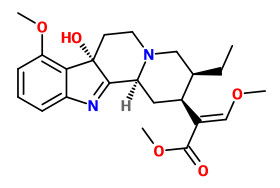Dies ist eine alte Version des Dokuments!
Mitragyna speciosa Korth. - Rubiaceae - kratom, kratum
Evergreen tree, native to Southeast Asia.
„The leaves of a tropical plant, Mitragyna speciosa KORTH (Rubiaceae), have been traditionally used as a substitute for opium. Phytochemical studies of the constituents of the plant growing in Thailand and Malaysia have led to the isolation of several 9-methoxy-Corynanthe-type monoterpenoid indole alkaloids, including new natural products. The structures of the new compounds were elucidated by spectroscopic and/or synthetic methods. The potent opioid agonistic activities of mitragynine, the major constituent of this plant, and its analogues were found in in vitro and in vivo experiments and the mechanisms underlying the analgesic activity were clarified. The essential structural features of mitragynines, which differ from those of morphine and are responsible for the analgesic activity, were elucidated by pharmacological evaluation of the natural and synthetic derivatives. Among the mitragynine derivatives, 7-hydroxymitragynine, a minor constituent of M. speciosa, was found to exhibit potent antinociceptive activity in mice.“
[Chemistry and pharmacology of analgesic indole alkaloids from the rubiaceous plant, Mitragyna speciosa., Takayama, H., Chemical and Pharmaceutical Bulletin, 52(8), 2004, 916-928] http://catbull.com/alamut/Bibliothek/Mytragina%20speciosa_pdf.pdf
„Kratom has been widely used in Southeast Asia for hundreds of years. In Thailand, kratom use typically
involves ingestion of the plant’s raw leaves or consumption of teas that are brewed or steeped from the leaves. Kratom leaves are used for their complex, dose-dependent pharmacologic effects. Low to moderate doses (1-5 g) of the leaves reportedly produce mild stimulant effects that enable workers to stave off fatigue. Moderate to high doses (5-15 g) are reported to have opioid-like effects. At these doses, kratom has been used for the management of pain, diarrhea, and opioid withdrawal symptoms, as well as for its properties as a euphoriant. Very high doses (>15 g) of kratom tend to be quite sedating and can induce stupor, mimicking opioid effects… .. Most of the opioid-like activity of kratom has been attributed to the presence of the indole alkaloids, mitragynine and 7-hydroxymitragynine. Both compounds have been shown to have analgesic and antinociceptive effects in animals, although 7-hydroxymitragynine is more potent.“
[Pharmacology of kratom: an emerging botanical agent with stimulant, analgesic and opioid-like effects., Prozialeck, W.C., Jivan, J.K., Andurkar, S.V., The Journal of the American Osteopathic Association, 112(12), 2012, 792-799] http://jaoa.org/article.aspx?articleid=2094342

